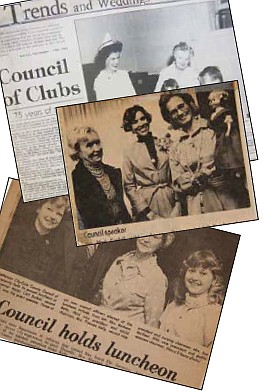The health and welfare of generations of Jefferson City area residents have been impacted by the Council of Clubs.
Organized by six local civic and social organizations in 1916, the Jefferson City Council of Clubs has evolved over time, but its focus on community health has remained constant.
"It's still a wonderful organization," said Dorothy Goodin. "We're still here for women's organizations to get information out about their organizations and activities."
Member clubs send representatives to the Monday afternoon meetings. The organizations exchange details about their respective projects and events, while also learning about community needs and programs from weekly speakers.
As its own organization, the Council of Clubs has hosted an annual fashion show since 1986, its only fundraiser. Proceeds each year benefit selected agencies and projects from an application process.
In 1971, they instituted the Student of the Month recognition.
Current President Gala Miller has been on the council for years, representing the Sterling Chapter of American Business Women.
"For the older women, the council has meant so much; they would not miss a meeting," Miller said.
The generational influence from older professional women to the younger generation and those community connections have been a great outcome.
In 1916, they established the community nurse position, paid her salary and provided a car. As the Cole County Health Department looks at its own 100th anniversary, its foundation also is rooted in this key action, said event chairman Vicki Myers.
The Council of Clubs also was involved with American Red Cross work during World War I and raised money for the Community Chest, a predecessor of the United Way.
In the 1920s and 1930s, members joined in highway beautification efforts, supported free lunch programs at schools and preserved fruits and vegetables for the less fortunate.
Into the 1940s, the club members promoted the Jefferson City Symphony, participated in a cleanup project with the chamber of commerce and headed World War II collection drives.
The club also endorsed legislation for premarital blood tests, established prenatal clinics at the Baptist mission in Washington Park, and hosted well-baby clinics.
Organized by six organizations and chartered by 13, the council had grown to 52 member clubs by the 1950s.
In 1955, they funded the local polio vaccinations and later that decade hosted worry clinics.
They later got involved with anti-drug programs, defensive driving education and babysitting training.
The community nurse program ended in 1974.
The council invested in SIDS monitors for families to take home from the hospital and electronic thermometers in the early 1980s.
In recent years, the council has provided inspirational books to Girl Scouts, career-specific uniforms to Dreams to Reality and relocation help for the Boys & Girls Club of the Capital City.
"I don't think people realize the impact we've made for health and welfare in this community," Myers said.
Many organizations today owe their origins to Council of Clubs' action, Miller said.
"There was a lot of need, and the council filled it," Goodin said.
Miller added, "They had a vision for things that were needed, and they had the expertise and ability to carry it through."
As the organization looks to its future, leaders recognize the council's member clubs have changed from mostly women who stayed home to professionals.
"We hope to continue to form a sense of community," Goodin said. "I enjoy being part of a group like this and this sense of belonging."

